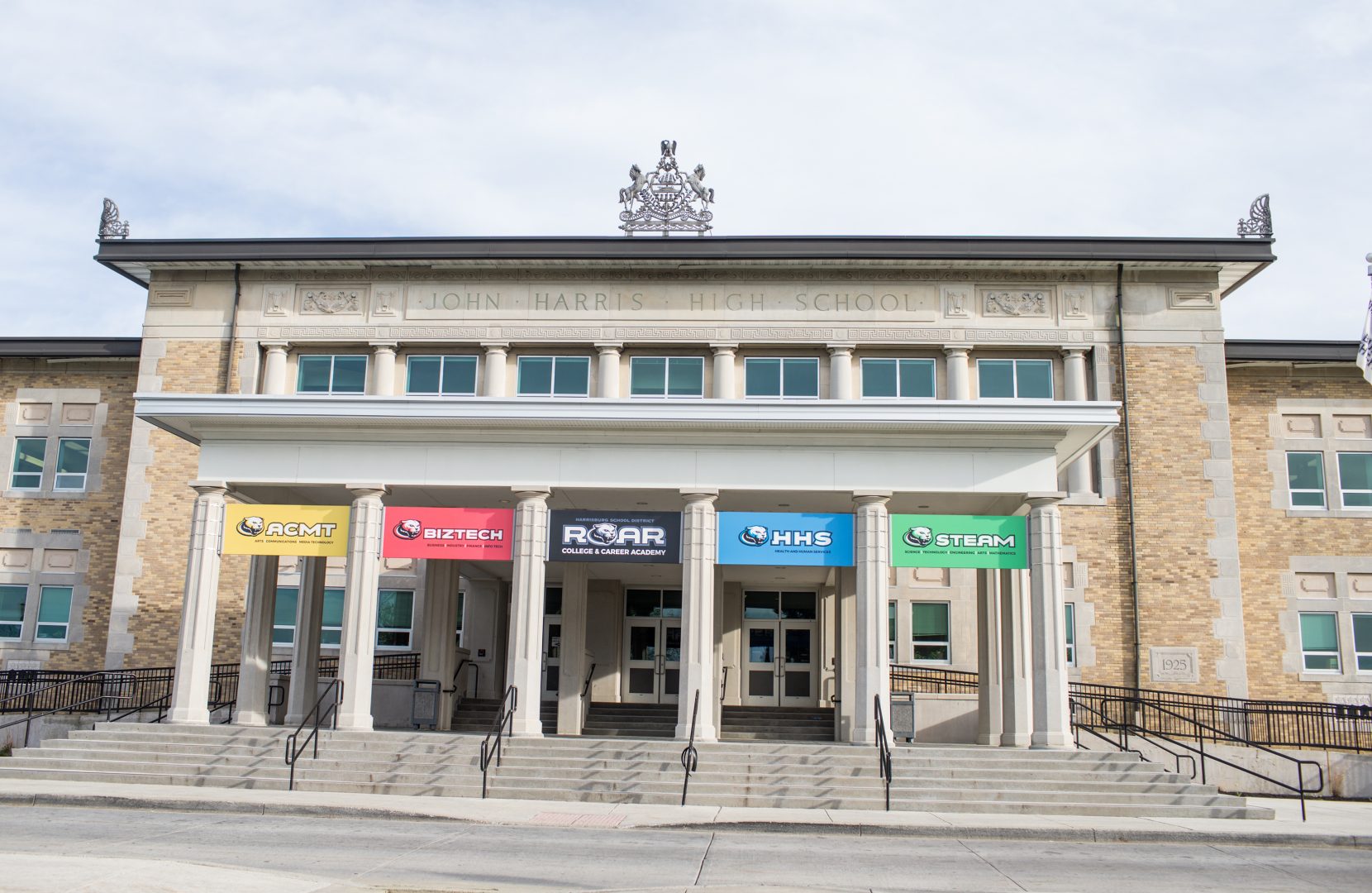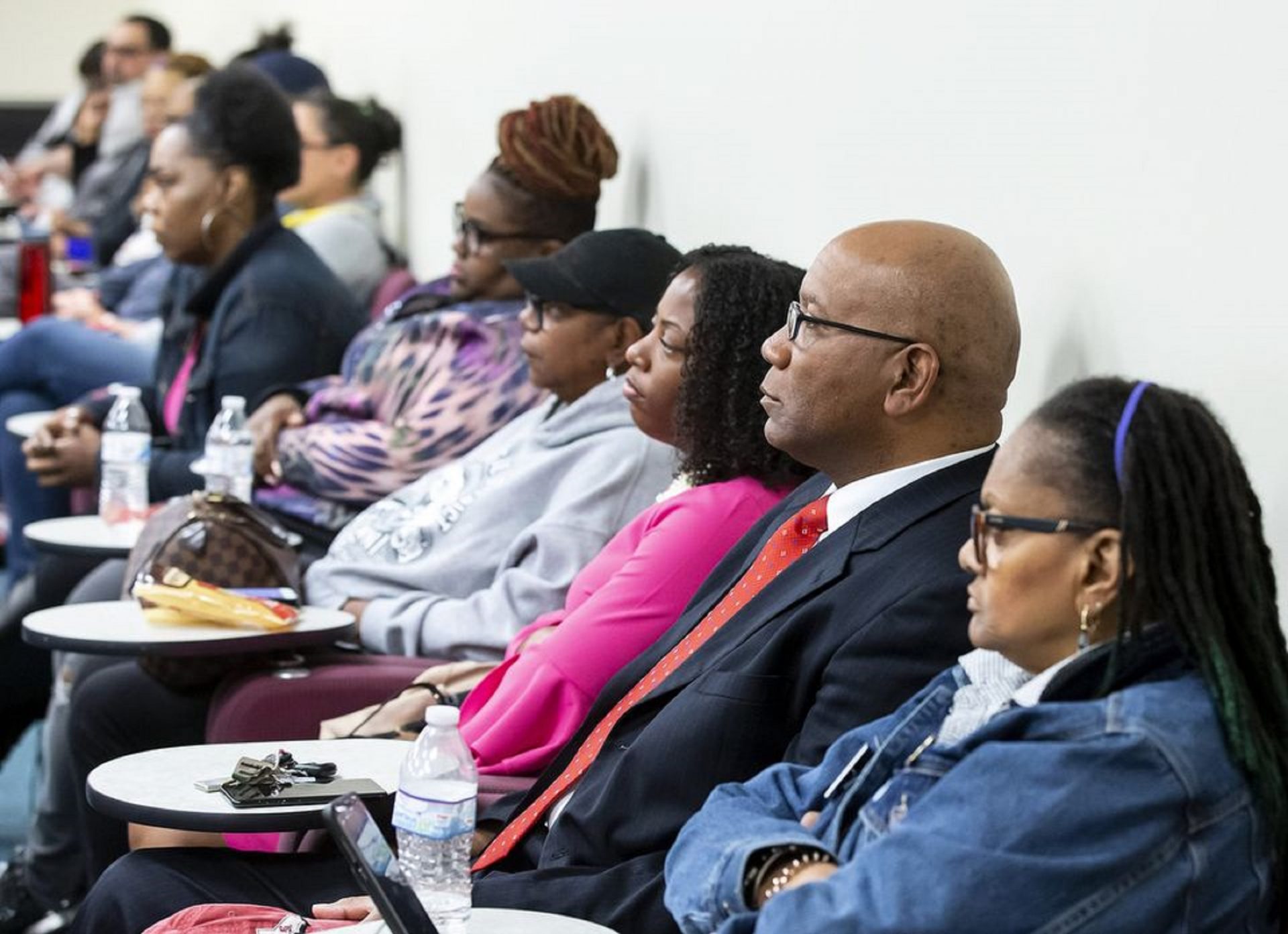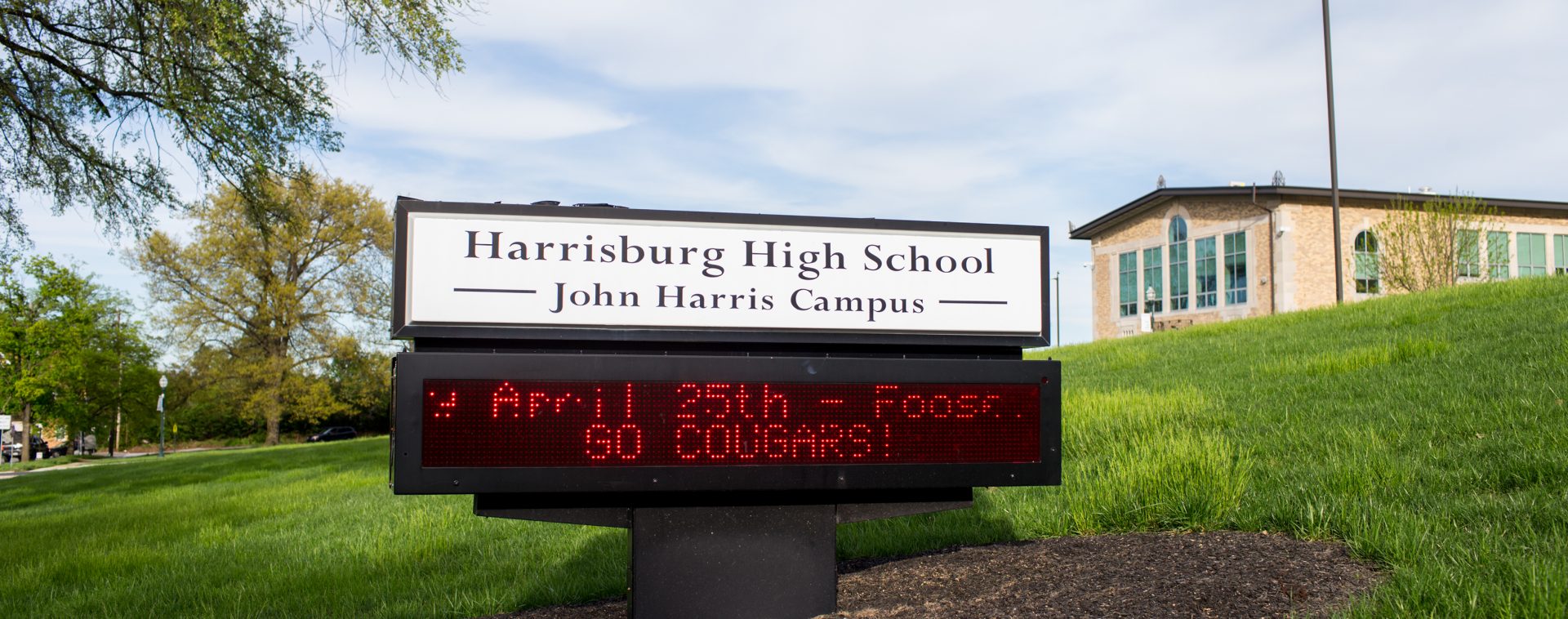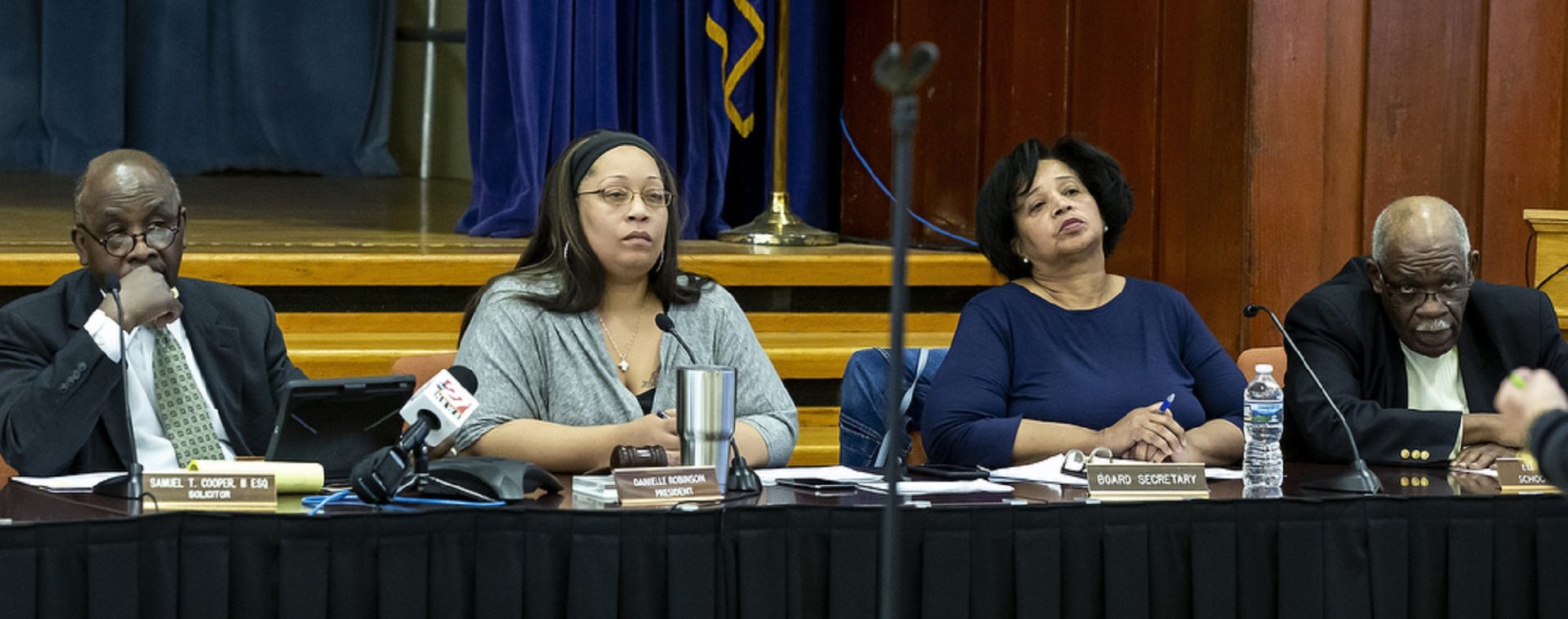
John Harris High School. April 24, 2019
Sean Simmers / PennLive

John Harris High School. April 24, 2019
Sean Simmers / PennLive

Sean Simmers / PennLive
John Harris High School. April 24, 2019
(Harrisburg) — Belinda Arterbridge joined the Harrisburg School District as a teacher in 2016, immediately after graduating from college.
Her initial joy of landing a job in her chosen field quickly turned to despair as students cursed at her, threw chairs and desks and started fights in the back of her third-grade school classroom.
Academics took a back seat because she was spending nearly all of her time simply trying to control the classroom. She didn’t have anywhere to turn for help.
“I was kicked, bit, spit on, cursed at, slapped, punched,” she said. “I came home with bruises covering my legs and, at one point, a black eye. At no point was any severe disciplinary action handed down for these infractions. Students might be suspended for a few days, but when they returned there was no plan of action, no support and no ‘real’ consequence for anyone, except for me.”
After serving under six principals at the same elementary school over two and a half years, including one who ignored 22 emails asking for help, Arterbridge quit in January.
She joined 70 others teachers who left the district this school year through mid-April, according to a tally of resigned teachers’ names presented monthly to school board members.
The departure rate is on pace to match last year’s churn when 83 teachers left the district, representing more than 18 percent of the teaching workforce.
That was the highest turnover rate recorded for a public school district across the state last year, according to a PennLive analysis of Department of Education teacher turnover data.
The next highest turnover rate was 16.9 percent recorded at the Sayre Area School District in Bradford County.
But the turnover percentage in Harrisburg may be even worse than the data suggests. That’s because more than 125 teachers left the district last year, according to school board meeting minutes. But 83 was the figure provided to the state education department.
District officials did not provide an explanation for the discrepancy. Repeated attempts to seek comment from Superintendent Sybil Knight-Burney for this story were unsuccessful.
PennLive interviewed five former Harrisburg teachers about their reasons for leaving. Most cited chaos in the classrooms, a political atmosphere at the top of the administration and a lack of systems, resources, and accountability across the district.
Several teachers who taught during the district’s era of “city control” from 2000 to 2010 said that was the time they could remember the district was running the best. The superintendent who was brought in, Gerald Kohn, understood the importance of systems and grants, and he established the best professional development of any district in the area, said Judy Conyers, who retired in 2016.
But those systems that saved money, such as yearly counting of textbooks, or filing for reimbursements for toileting, feeding and self-care of special education students, fell away the year after Kohn left, said Nancy Adams, who left the district in 2015 after 14 years teaching special education.

Vicki Vellios Briner / PennLive
Harrisburg city residents meet at PA Careerlink to discuss current affairs at Harrisburg School District including the call for receivership from several elected officials, April 29, 2019.
When she left, district officials told her she was eligible for continued health care coverage, even though she wasn’t. She hadn’t completed 15 years, which was the minimum threshold, but had to repeatedly refuse human resources employees who insisted she was eligible.
As it turns out, union officials last year discovered a systemic problem where the district had been paying to keep 54 former employees on the district’s healthcare plan as “active employees” long after they left the district. It was one of several financial scandals revealed last year.
Other systems that fell by the wayside included a focus on harnessing grant money. The district has not employed a grant writer in recent years.
“There’s nothing coming in right now as far as grants,” said Linda M. Cammack, a former teacher and former school board member. “That’s why we’re failing so much.”
Lacking money, it’s hard to get anything accomplished, teachers said. Their salaries used to be so competitive that teachers were reluctant to leave the district. But the district pay has fallen behind, leaving one less reason to stay in the troubled district.
Serious professional development for teachers dried up too, Conyers said.
“There was no serious professional development for teachers whatsoever,” she said. “We didn’t have anybody really leading us.”
Arterbridge wrote up student infractions but said there was no follow-up by the administrators in her building, who were under pressure from the top to keep suspensions and expulsions down.
Instead, it was Arterbridge who was put in the hot seat. She said an administrator talked to her about her voluminous write-ups and said she wasn’t going to last long in the district unless she could toughen up.
She started using a “buddy room,” where students could go to cool down if they acted out, but was chastised for using the room too much. When she used the room less, she said she was criticized for not taking advantage of that resource.
“I was getting a lot of mixed signals,” she said, which wasn’t helpful as a first-year teacher. “I had an advisor, or mentor, assigned to me but she quit halfway through the year.”
Arterbridge’s next two years with the district weren’t any better. Because of staffing vacancies last year, her classes ballooned up to 40 students on some days.
One thing that she said became very clear: “I was on my own,” she said.
District administration has a duty to support the teachers, Cammack said.

Sean Simmers / PennLive
Harrisburg High School is seen in this April 24, 2019 photo.
“The teachers are the ones who are attempting to do the right thing,” she said. “But if they get no support, what good are you?”
Cammack said she has witnessed the district decline since she started teaching at William Penn High School in 1978. She later left to lead a program at HACC, then won a four-year seat on the school board in 1996 to try to fix things that were going wrong. She returned as a student support specialist in the district until that job was eliminated in 2009. She now drives a school bus for the district.
Because teacher turnover is so closely tied to student achievement, erasing the teacher exodus has been a goal in the district’s state-sponsored recovery plan since 2016.
The turnover, particularly in core subjects, has been cited by Superintendent Sybil Knight-Burney as one the primary reasons for low standardized test scores under her leadership. She addressed the importance of teachers when asked to speak at an educational conference April 23 in Washington D.C.
“No matter what anybody else says, I’ve been a principal, I’ve been a teacher, I’ve been a superintendent,” Knight-Burney said in her speech to the conference. “What a teacher does in the classroom counts the most.”
While the superintendent recognizes the importance of treating teachers as professionals, the district’s stance in recent months has been adversarial.
The district has engaged in several public spats with the teachers’ union over grievances, improper pay and a new contract. Meanwhile the teachers’ contract has been expired for nearly a year and specific ideas to address teacher turnover have been “tabled” for two years as the district is unable to negotiate a new contract.
While many districts require exit interviews to find out why teachers are leaving and address those concerns, Harrisburg hasn’t been doing exit interviews in recent years.
Education experts say the value of stable staffing at schools can’t be overstated.
“Good schools have a sense of community,” Richard M. Ingersoll, a University of Pennsylvania professor and expert in school staffing, told the Philadelphia Inquirer for a recent investigation on excessive turnover at certain Philly schools. “The teachers, the students, the staff. They’re like a family. Turnover this high means there’s no continuity…It’s a really terrible situation.”
The high exit rate of Harrisburg teachers persists as the district struggles with annual budget deficits, a series of financial scandals and calls from the city’s mayors and lawmakers for the state to take over the district.
Meanwhile, more teachers are leaving Harrisburg every month.

Vicki Vellios Briner / PennLive
The Harrisburg School District Board held a special meeting to vote on hiring in-house solicitor James Ellison, Monday, April 22, 2019.
Many times, the growing teacher vacancies are filled with brand-new teachers. When that happens year after year, there aren’t enough veteran teachers to serve as “peer models,” teachers said, which exacerbates the situation.
Teachers who are still learning how to be teachers are faced with additional challenges of teaching in an urban district without proper preparation. Building administrators are often overworked or underqualified, the teachers said, and those positions are turning over just as fast.
The district’s 85 percent poverty rate, among the highest of any district in the state, is substantial, said Dr. Sharon Wolf of the University of Pennsylvania. Coming from an impoverished family can negatively affect a student’s learning, but those difficulties are exponentially worse when a student grows up in a neighborhood of concentrated poverty, she said.
Problems in a student’s home or neighborhood are often carried with them into the classroom, where they can exhibit as bad behavior.
Much of the bad behavior wasn’t the fault of the students, teachers told PennLive. The majority of Harrisburg students have experienced repeated trauma, but there weren’t enough services available in the school district to address the problems, the teachers said.
Principal and counselor job — people who previously assisted with behavior issues — were among those cut in recent years to try to balance the district’s annual budget.
Many of the misbehaviors are clearly cries for help, but nothing is done to address root problems, the teachers said. Instead, the student body has quickly learned that there are no consequences for bad behavior.
“My big thing was, if you don’t discipline the small stuff and let it go,” a former Camp Curtin teacher said, “Then it’s going to hit the fan with the big stuff.”
She once fell to the floor and broke her arm while trying to break up a fight in her classroom. Once, a student spit directly into her face.
“If you’re allowed to fight in school and that’s okay, what is that teaching you?” the 9-year veteran said. “We’re not teaching them that they are assaulting people and they can’t do that.”
Several teachers described problems in their classroom escalating when additional students were temporarily added to their classrooms when no teacher was available for their original class. Administrators would “split” the classrooms lacking a teacher into other classrooms. At one point, 12 teachers were absent at Camp Curtin but the district could only find three substitutes. So all those children had to be pushed into other classrooms for the day.

Vicki Vellios Briner / PennLive
Harrisburg city residents meet at PA Careerlink to discuss current affairs at Harrisburg School District including the call for receivership from several elected officials, April 29, 2019. Ana White asks a question during the meeting.
“It became impossible to teach,” said the 9-year veteran, who didn’t want her name published because she eventually wanted to return to teaching. “It got to the point most of the kids were acting out but there would be a few who would just be looking at me like, ‘Please, teach me.’ But I couldn’t because it was too unruly. It was a terrible feeling.”
The teacher said she thinks the Harrisburg School District could be “great” if the administration started its own alternative school again and pulled the most troubled students out of each building early in the school year. That alone, would be more effective than all the expensive contracted services the district is doing to try to address multiple problems.
That would leave the students who really want to learn, and they would be surrounded by other kids who are doing the right thing, she said.
The district used to have its own alternative education program at the old William Penn High School building and that allowed a place for students who could not learn in a traditional environment. Now the district contracts with a private company, Camelot, that charges more than $17,000 per student.
District officials would not answer questions about discipline procedures or the number of students referred to Camelot. But the district website says the maximum combined enrollment in the three Camelot programs is 200 students: 24 in the K-5 program, 146 in the 6-12 program and 30 in the accelerated program.
The district has an enrollment of about 6,300 students.
The tools available to teachers to deal with students acting out and disrupting classrooms are typically reactive, according to the teachers’ union, including detention, in-school and out-of-school suspensions, rather than proactive.
“We have appealed to the administration to provide tools that build the skills and address the mental health needs of our students,” said Jody Barksdale, president of the Harrisburg teachers union, “such as effective programs for social-emotional learning that we have used successfully in the past and a return to our own in-house alternative education program.”
But, Barksdale said: “Our pleas have fallen on deaf ears.”
Barksdale said the district recently ended a student counseling program with an agency called Pressley Ridge, without replacing it with other counseling services.
“Some of our teachers have left after being physically hurt by a student acting out,” Barksdale said. “For many teachers, being unable to have the tools and support needed from the district to help their students and manage their classrooms is overwhelming and can be the final straw that leaves them feeling like they have no choice but to leave teaching in the district.”
Staff Writer Daniel Simmons-Ritchie provided the data analysis for this report.
PennLive and The Patriot-News are partners with PA Post.

Sometimes, your mornings are just too busy to catch the news beyond a headline or two. Don’t worry. The Morning Agenda has got your back. Each weekday morning, host Tim Lambert will keep you informed, amused, enlightened and up-to-date on what’s happening in central Pennsylvania and the rest of this great commonwealth.
The days of journalism’s one-way street of simply producing stories for the public have long been over. Now, it’s time to find better ways to interact with you and ensure we meet your high standards of what a credible media organization should be.